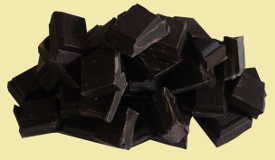What Is Dark Chocolate? Ingredients and Differences.
|
What is dark chocolate? I wish I could give you a simple, straightforward, universally accepted answer to this question. However, there is no single formula for dark chocolate. It varies. (Like life.) |
 |
In the Europe, dark chocolate is defined as having at least 35% cocoa solids.
Based really on nothing more than the contrast between the phrases "milk chocolate" and "dark chocolate," I used to assume there was no milk in dark chocolate. It turns out this is not always true.
In the U.S. there is no official definition of dark chocolate, however both semisweet and bittersweet are defined as having at least 35% chocolate liquor and less than 12% milk solids.
So if you are allergic to milk, you need to study the ingredients label.
In practice, because of market demand (that's you and me), most dark chocolate these days has more (often much more) than that amount. And there is an increasing trend for dark chocolate to show its cocoa content on the label. A practice that was exceedingly rare before about 2000.
Despite the wide variety of what is dark chocolate?, it all has certain things in common.
Dark chocolate has more cocoa solids, less sweetener, and less (or no) milk compared to other types of chocolate. We might say that "pure" dark chocolate consists only of chocolate liquor (chocolate mass or cocoa mass) and sugar. In practice it is rare to find a product with a 2-item ingredient list.
For a practical example, let's consider the ingredient list for Trader Joe's 72% Dark Chocolate.
And here it is:
▪ Cocoa mass (the whole cocoa bean core (nib), ground up)
▪ Sugar
▪ Cocoa butter (the fatty part of the cocoa bean)
▪ Soy lecithin (makes the chocolate pourable enough to go into the mold)
This would be the 2-item list except for the addition of cocoa butter and soy lecithin.
Although the label doesn't say, lecithin is normally added to chocolate in quite small amounts. Usually less than 1%, almost never more than 2%.
And I would argue that cocoa butter isn't really a third ingredient, because it's just some more of part of the cocoa mass.
There is no hard and fast rule as to in what order or amounts certain ingredients may appear as we descend the scale of chocolate darkness.
That said, let's look at the general progression from pure dark chocolate to barely dark:
Ultimate dark chocolate -
cocoa mass.
(Also called chocolate mass or chocolate liquor, and commonly called baker's chocolate or bitter chocolate.)
Sweet enough to eat -
add sugar.
Most commercial dark chocolate -
add some additional cocoa butter and frequently some soy lecithin
to make it easier to mold into bars or other shapes.
Moving farther towards the light edge of the dark chocolate scale -
still more sugar and less cocoa;
milk or cream, vanilla….
Cheaper chocolate -
milk fat instead of milk;
vanillin instead of real vanilla;
corn syrup or other sweeteners;
etc….
Much cheaper chocolate -
vegetable oil;
artificial flavor, artificial color;
replace or supplement the soy lecithin with chemical emulsifiers such as PGPR;
et cetera….
And of course there is often more in a chocolate bar than just chocolate. What I refer to as add-ins:
from the usual - nuts, fruit...;
to the unusual - hot peppers, bacon, coffee...;
to the say what? - insects... (no, on purpose - really!);
and so forth….
Now you know what dark chocolate is. Any questions? You know where my Contact page is!
The first commercial chocolate bar was made in Bristol, England in 1847 by J. S. Fry & Sons.
I presume it was dark, as milk chocolate was not invented until 1875.




